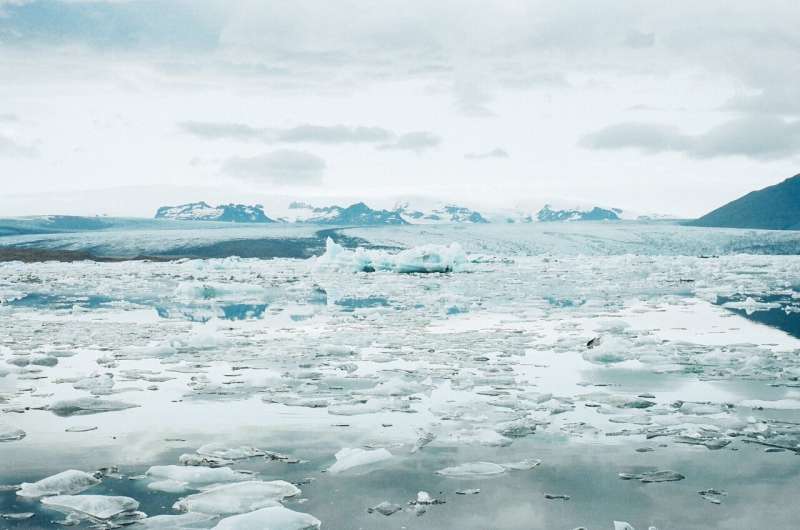This article has been reviewed according to Science X's editorial process and policies. Editors have highlighted the following attributes while ensuring the content's credibility:
fact-checked
peer-reviewed publication
trusted source
proofread
Mystery behind huge opening in Antarctic sea ice solved

Researchers have discovered the missing piece of the puzzle behind a rare opening in the sea ice around Antarctica, which was nearly twice the size of Wales and occurred during the winters of 2016 and 2017.
A study published in Science Advances reveals a key process that had eluded scientists as to how the opening, called a polynya, was able to form and persist for several weeks. The paper is titled "Ekman-Driven Salt Transport as a Key Mechanism for Open-Ocean Polynya Formation at Maud Rise."
The team of researchers from the University of Southampton, the University of Gothenburg and the University of California San Diego studied the Maud Rise polynya—named after the submerged mountain-like feature in the Weddell Sea, over which it grows.
They found the polynya was brought on by complex interactions between the wind, ocean currents, and the unique geography of the ocean floor, transporting heat and salt towards the surface.
In Antarctica, the surface of the ocean freezes over in the winter, with sea ice covering an area about twice the size of the continental United States.
In coastal areas, openings in the sea ice occur every year. Here, strong coastal winds blow off the continent and push the ice away, exposing the seawater below. It is much rarer for these polynyas to form in sea ice over the open ocean, hundreds of kilometers away from the coast where the seas are thousands of meters deep.
Aditya Narayanan, a Postdoctoral Research Fellow at the University of Southampton, who led the research, said, "The Maud Rise polynya was discovered in the 1970s when remote sensing satellites that can see sea ice over the Southern Ocean were first launched. It persisted through consecutive winters from 1974 to 1976 and oceanographers back then assumed it would be an annual occurrence. But since the 1970s, it has occurred only sporadically and for brief intervals.
"2017 was the first time that we've had such a large and long-lived polynya in the Weddell Sea since the 1970s."
During 2016 and 2017, the large circular ocean current around the Weddell Sea became stronger. One of the consequences of this is that the deep layer of warm, salty water rises, making it easier for salt and heat to mix vertically into the surface water.
Fabien Roquet, a Professor in Physical Oceanography at the University of Gothenburg and co-author of the research, said, "This upwelling helps to explain how the sea ice might melt. But as sea ice melts this leads to a freshening of the surface water, which should in turn put a stop to the mixing. So, another process must be happening for the polynya to persist. There must be an additional input of salt from somewhere."
The researchers used remotely sensed sea ice maps, observations from autonomous floats and tagged marine mammals, alongside a computational model of the ocean's state. They found that as the Weddell Sea current flowed around Maud Rise, the turbulent eddies moved salt onto the top of the sea mount.
From here, a process called "Ekman transport" helped to move the salt onto the northern flank of the of Maud Rise, where the polynya first formed. Ekman transport involves water moving at a 90-degree angle to the direction of the wind blowing above, influencing ocean currents.
"Ekman transport was the essential missing ingredient that was necessary to increase the balance of salt and sustain the mixing of salt and heat towards the surface water," said co-author Professor Alberto Naveira Garabato, also from the University of Southampton.
Polynyas are areas where you have a huge amount of transfer of heat and carbon between the ocean and the atmosphere. So much so that they can affect the heat and carbon budget of the region.
Professor Sarah Gille from University of California San Diego, another co-author of the research said, "The imprint of polynyas can remain in the water for multiple years after they've formed. They can change how water moves around and how currents carry heat towards the continent. The dense waters that form here can spread across the global ocean."
Some of the same processes that were involved in the forming of the Maud Rise polynya, such as the upwelling of deep and salty water, are also driving a general reduction in sea ice in the Southern Ocean.
Professor Gille added, "For the first time since observations began in the 1970s, there's a negative trend in sea ice in the Southern Ocean, which began around 2016. Before then it had remained somewhat stable."
More information: Aditya Narayanan, Ekman-Driven Salt Transport as a Key Mechanism for Open-Ocean Polynya Formation at Maud Rise, Science Advances (2024). DOI: 10.1126/sciadv.adj0777. www.science.org/doi/10.1126/sciadv.adj0777
Journal information: Science Advances
Provided by University of Southampton





















